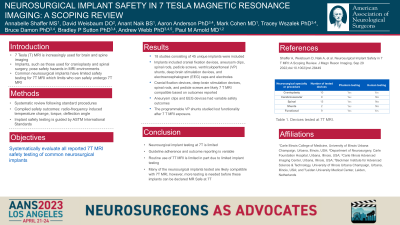Neurosurgical Implant Safety in 7 Tesla Magnetic Resonance Imaging: a Scoping Review
Neurosurgical Implant Safety in 7 Tesla Magnetic Resonance Imaging: A Scoping Review
Friday, April 21, 2023


Annabelle Shaffer, MS (she/her/hers)
Medical Student, Class of 2025
Carle Illinois College of Medicine
Champaign, Illinois, United States
ePoster Presenter(s)
Introduction: The use of 7 Tesla (T) magnetic resonance imaging (MRI) is expanding across neurosurgical and neurologic specialties. However, few neurosurgical-related implants have been tested for safety at 7T, limiting its use in patients with cranial fixation, shunt placements, and other implants. Implant safety can be determined via the American Society for Testing Materials International (ASTM) guidelines. This systematic review seeks to summarize all neurosurgical-related implants that have been tested for safety in 7T MRI.
Methods: A systematic search adherent to PRISMA guidelines was performed using PubMed, MEDLINE, Web of Knowledge and citation matching. Studies written in English that included at least one neurosurgical implant and at least one safety outcome were included. Data were extracted for implant studied, implant composition, deflection angle, torque, temperature change, and ASTM guidelines followed.
Results: Overall, 18 studies consisting of 45 unique implants were included. Implants included: cranial fixation devices, aneurysm clips, spinal rods, pedicle screws, ventriculoperitoneal (VP) shunts, deep brain stimulation devices, and electroencephalogram (EEG) caps and electrodes. Cranial fixation devices, deep brain stimulation devices, spinal rods, and pedicle screws are likely 7T MRI compatible based on outcomes reported. Aneurysm clips and EEG devices had variable safety outcomes. The programmable VP shunts studied lost functionality after 7T MRI exposure.
Conclusion : We identified several implants that are likely compatible with 7T MRI. Given the growth in 7T imaging and expansion of the technology, neurosurgical implants should be constructed with the aforementioned safety considerations. Caution must be taken with all implants, especially aneurysm clips, programmable VP shunts, and EEG recording devices.
Methods: A systematic search adherent to PRISMA guidelines was performed using PubMed, MEDLINE, Web of Knowledge and citation matching. Studies written in English that included at least one neurosurgical implant and at least one safety outcome were included. Data were extracted for implant studied, implant composition, deflection angle, torque, temperature change, and ASTM guidelines followed.
Results: Overall, 18 studies consisting of 45 unique implants were included. Implants included: cranial fixation devices, aneurysm clips, spinal rods, pedicle screws, ventriculoperitoneal (VP) shunts, deep brain stimulation devices, and electroencephalogram (EEG) caps and electrodes. Cranial fixation devices, deep brain stimulation devices, spinal rods, and pedicle screws are likely 7T MRI compatible based on outcomes reported. Aneurysm clips and EEG devices had variable safety outcomes. The programmable VP shunts studied lost functionality after 7T MRI exposure.
Conclusion : We identified several implants that are likely compatible with 7T MRI. Given the growth in 7T imaging and expansion of the technology, neurosurgical implants should be constructed with the aforementioned safety considerations. Caution must be taken with all implants, especially aneurysm clips, programmable VP shunts, and EEG recording devices.
